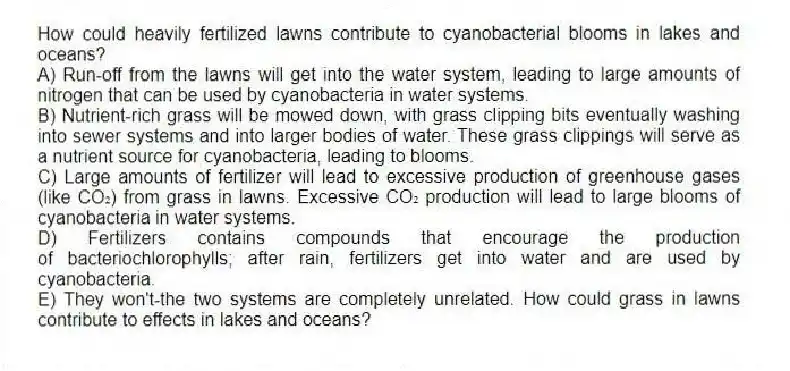
How could heavily fertilized lawns contribute to cyanobacterial blooms in lakes and oceans?
A) Run-off from the lawns will get into the water system, leading to large amounts of nitrogen that can be used by cyanobacteria in water systems.
B) Nutrient-rich grass will be mowed down, with grass clipping bits eventually washing into sewer systems and into larger bodies of water. These grass clippings will serve as a nutrient source for cyanobacteria, leading to blooms.
C) Large amounts of fertilizer will lead to excessive production of greenhouse gases (like CO₂) from grass in lawns. Excessive CO₂ production will lead to large blooms of cyanobacteria in water systems.
D) Fertilizers contains compounds that encourage the production of bacteriochlorophylls; after rain, fertilizers get into water and are used by cyanobacteria.
E) They won't-the two systems are completely unrelated. How could grass in lawns contribute to effects in lakes and oceans?
Correct Answer:
Verified
Q69: Which of the following genera are obligate
Q70: How do anoxygenic phototrophs benefit from having
Q71: Relatively little is known about many obligate
Q72: Which of the following genera have dormant
Q73: Which of the following is NOT associated
Q75: The most medically relevant species of Pseudomonas
Q76: The genomes of free-living spirochetes are larger
Q77: What distinguishes Staphylococcus, species from Streptococcus, Enterococcus
Q78: A student complains that it makes no
Q79: Which of the following are spirochetes?
A) Borrelia
Unlock this Answer For Free Now!
View this answer and more for free by performing one of the following actions

Scan the QR code to install the App and get 2 free unlocks

Unlock quizzes for free by uploading documents